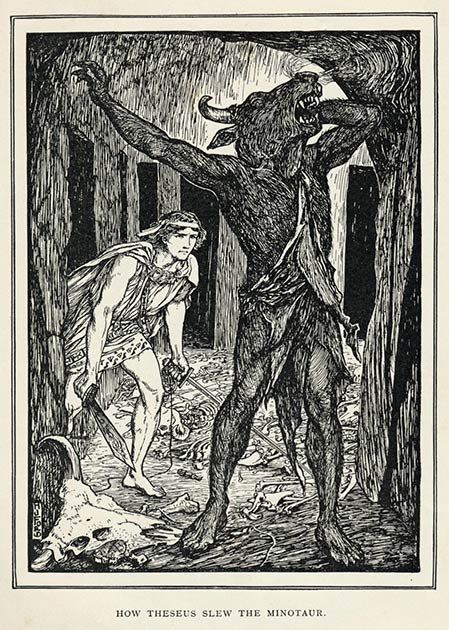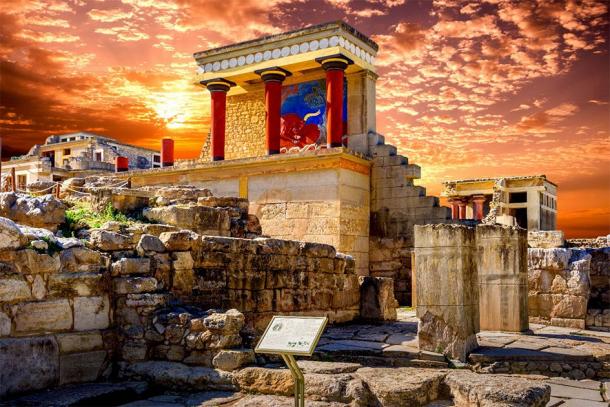
The Mythological Reality of the King Minos Golden Ring
Over the last two centuries, since archaeologists have been actively digging in the ground searching for evidence of lost civilizations, there have been countless discoveries of ancient cities, magnificent temples and spectacular stone monuments raised in honor of the gods. This stands as a reminder that in worlds much older than our own, in times void of scientific understanding, what is read today as mythology was often reality. This would suggest that fairytales can be built on facts which can become archaeological treasure. The central mythological artifact in this particular story is an ancient gold seal ring which the world’s leading archaeologists and specialists of ancient Greek culture claimed was a hoax for almost 100 years. It has now been proven to be an authentic artifact that is about 5,300 years old and is considered to be one of the most valuable rings ever discovered. This is the factual story of the supposedly mythological, “Golden Ring of King Minos”.
The Maze, The Monster And The King Minos Ring
In Greek mythology, King Minos was the son of Zeus, the sky and thunder god who was himself the king of the gods of Mount Olympus. King Minos’ mother, Europa, was the female personification of the continent of Europe.
As the first ruler of Crete, King Minos ordered King Aegeus to select seven young boys and an equal number of young girls, once every nine years, who were sent into Daedalus’ death maze at Knossos, where they would be eaten by the Minotaur.
Greek folkloric and mythological texts recount that Minos obtained the throne of Crete with help from the god Poseidon. He colonized many of the Aegean islands after winning several fierce battles with pirates. King Minos then married Pasiphae, the daughter of Helios and mother of the Minotaur, and together they had three children: Androgeos, Ariadne, and Phaedra. After King Minos died he became the high judge of human souls in the Greek underworld.

Theseus slays the Minotaur. (Archivist / Adobe Stock)
The story of the King Minos Ring has its origins in mythology when King Minos hurled the sacred artifact into the Aegean Sea. It was discovered again by Theseus, the hero who killed the Minotaur in the Knossos labyrinth. The ring vanished from history at this point. Its last known location was somewhere in the palaces of Knossos.
In 1878, another Minos, Minos Kalokairinos, a Cretan merchant and amateur antiquarian, discovered the ruins of the ancient city Knossos, which is often referred to as Europe's oldest city. On March 16, 1900, British archaeologist Arthur Evans privately purchased the Knossos site and excavated the site for the next 20 years. Evans is credited with the discovery of the “lost” civilization of Minoan culture.
- Magical Rings and Their Mystical Powers
- In Search of the Mythical King Minos, Did the Legendary Ruler Really Exist?
- The Legendary Cretan Labyrinth Cave: Inspiration for the Story of King Minos and the Labyrinth of the Minotaur?
Even The Best Of Us Get It Terribly Wrong Sometimes
Knossos was a vast religious and administrative center comprising more than 1000 interlocking buildings. This Mediterranean trading power center was first occupied around 7000 BC, during the Neolithic period. By the 19th to 16th centuries BC, the Knossos settlement was home to about 5000-8000 people.

The north entrance of the Knossos Palace and the charging bull fresco in Crete, Greece. (gatsi / Adobe Stock)
However, according to the 2013 book Crete (Greece) “shortly after 1,700 BC the palace and surrounding city boasted a population of 100,000 people.”
In a report on Steemit, the King Minos Ring is viewed today as “one of the most significant symbols of the Minoan Civilization.” But in the late 1920s, when the King Minos Ring was first presented to archaeological authorities it was declared a fake. And for the next 73 years the ring was viewed as a hoax. However, when this supposedly fake King Minos Ring was handed over to authorities in 2001, a Greek-international committee determined the supposed ancient artifact was indeed authentic. At that point, the once mythological King Minos Ring was valued it at $350,000 US.
An article in the Greek Reporter states that in the summer of 1928 a little local boy was playing in the ancient Knossos ruins when he found the legendary “ring of King Minos.” The article goes on to say that the boy’s father gave the ring to Father Polakis, “the meddlesome village priest,” who tried to sell it for a huge sum to the archaeologist Sir Arthur Evans. Evans declined to buy the artifact.
However, in 1933 or 1934, Father Polakis approached archaeologists Nikolaos Platon and Spyridon Marinatos at the Museum of Heraklion. Platon believed the artifact to be genuine, but Marinatos thought it was a high-quality forgery. As a result, the ring was ultimately deemed as a fake and was returned to the priest.

Front detail of the King Minos Ring. (CC0)
While the two museum archaeologists never bought the artifact from the priest they did press the ring into plasticine and made two copies. After almost 20 years of thinking about the meaning of the many tiny symbols imprinted on the plasticine copies, Platon asked the priest if he could see the ring again to analyze it with more modern methods. But the priest claimed his wife had accidentally lost it and the ring “disappeared” for the next seven decades.
When Mythology Turns Into Reality
The King Minos Ring is described in Arthur Evans book Palace of Minos and in the works of Platon the archaeologist. It is described as a “gold jewel seal ring” cast in pure gold and weighing about one ounce (29.4 grams), with the face of the ring divided into two levels.
The lower level shows a woman in a boat at sea with three shores in the background. To the right of this scene another woman it trying to pull down a tree. The middle of the ring depicts a mountain and an altar with a tree on top of it being pulled at by yet another smaller female figure.
The other level of the ring shows a figure sitting on a settlement and another female figure either ascending to or descending from the sky.
According to a Greek-language study by Mr Antonis Vasilakis, a researcher of prehistoric writing and a relative of the boy who originally found the ring, the left side of the ring represents the “worship of mother Dimitra with specific rituals, while there are offerings to the Big Mother Rhea and to Big Mother Artemis.”
And adding to the immense value of the ring, in an article on Antiquated Antiquarian Dr Minas Tsikritzis said the symbols have been executed so clearly “that most probably they used some sort of lenses in order to carve them.”
The ring was found again in 2001. An article in Kathimerini explains that in 2001 a Mr Kazantzis inherited the priest’s house and found the ring during a house restoration project.
On Tuesday, July 23rd 2002, a special ceremony on Crete, led by the former Minister of Culture, reached its highpoint when the King Minos Ring was officially handed to archaeologists at the Heraklion Archaeological Museum, where it is now exhibited on the first floor.
In 2002, The Telegraph reported that a committee of Greek and foreign experts “agreed upon the authenticity of the ring, after numerous tests were conducted.” This 5,300-year-old seal ring is now considered one of the most valuable of its kind ever discovered.
In 2002, Greek Culture Minister Evangelos Venizelos told CBC News that “the engraved Minos Ring was worth about $350,000 on the antiquities market.” In the end, the King Minos Ring of Greek folklore, long dismissed as a fake, became an authenticated treasure from Minoan civilization.
 Life is stranger than fiction, they often say. And that’s true for history as well! As we regain lost knowledge of our past by uncovering amazing and surprising, even bizarre artifacts, we’re sometimes left to puzzle—which are true artifacts, and which are works of fiction? Was it a real find, or all a hoax? To discover the truth of history, all we can do is: read, examine, consider, and judge.
Life is stranger than fiction, they often say. And that’s true for history as well! As we regain lost knowledge of our past by uncovering amazing and surprising, even bizarre artifacts, we’re sometimes left to puzzle—which are true artifacts, and which are works of fiction? Was it a real find, or all a hoax? To discover the truth of history, all we can do is: read, examine, consider, and judge.
Top image: King Minos Ring of Greek folklore, long dismissed as a fake, is now an authenticated treasure from Minoan civilization. Source: CC BY 3.0
By Ashley Cowie
















Comments
Hello Ashley,
Well this is certainly exciting news to read about in your article thank you for sharing learn something new everyday.
Only question I have is what is it with children their always finding key items that are linked to the Distant past of our Ancient Ancestors.
Like the 14 year old Arab herder goofing off while looking for strays then throwing Stones into a cave before we know it The Dead Sea Scrolls are found.
Considering the implications with the King Minos Ring that is until someone else comes along and goes back to the original declaration of it being a Fake this gives the possibility; that since Minos walked the Earth what if a zeus did as well?
From what I've been Studying in the book Enoch I'm beginning to think that the quote olympians is their identity that was their Clan Name.
For instance, after the Great Flood and the World began again through Noah's 3 Son's Shem, Ham, Japheth each person's from their bloodline carried the Family name of their Patriarch.
We know that Shem's lineage is ID as Semite. The Semites bloodline settled in Asia Minor and small places in Europe likewise Russia. Correct me if I'm wrong but, Asia Minor is what we often refer to as The Middle East.
Anyhow this is indeed exciting news to read I hope more discoveries are made like that of the King Minos Ring Seal.
The authenticity of this ring could go either way. If you look closely at the etching, you can see that two of the figures look like women wearing some sort of leggings and two of the figures look like men. I’m most curious about the 8 hollowed out ovals across the center of the ring. I’m leaning toward this ring being real and our interpretation of its symbolism being what’s making us call it a fake. If this ring is real, (and couldn’t the gold alone give us a clue as to its authenticity?) then it’s priceless.